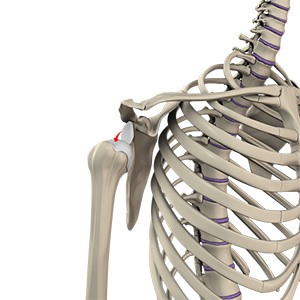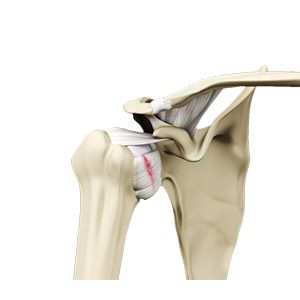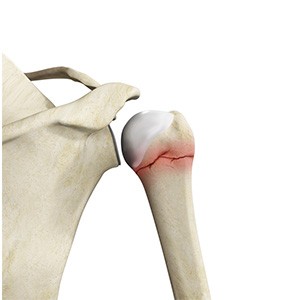- Anatomy
- Conditions
- Procedures
Rotator Cuff Tear

The rotator cuff is a group of tendons in the shoulder joint that provides support and enables a wide range of motion. A major injury to these tendons may result in rotator cuff tears. It is one of the most common causes of shoulder pain in middle-aged and older individuals.A rotator cuff tear may occur with repeated use of the arm for overhead activities, while playing sports, or from a motor accident.
Shoulder Pain

Pain in the shoulder may suggest an injury, which is more common in athletes participating in sports such as swimming, tennis, pitching, and weightlifting. The injuries are caused due to the over usage or repetitive motion of the arms.In addition to pain, shoulder injuries also cause stiffness, restricted movements, difficulty in performing routine activities and popping sensation.
Snapping Scapula

Snapping scapula or snapping scapula syndrome is also known as scapulothoracic syndrome or scapulocostal syndrome. It is a condition characterized by painful clicking, snapping, or grinding of the shoulder blade. The sound occurs as a result of rubbing of soft tissues between the thoracic wall and the scapula. The soft tissues stuck in between these two structures may be a muscle, tendon, or bursa. Snapping scapula is most commonly found in young and active individuals who are involved in repetitive overhead activities.
Shoulder Impingement

Shoulder impingement is the inflammation of the tendons of the shoulder joint. It is one of the most common causes of pain in the shoulder. Shoulder impingement is also called swimmer’s shoulder, tennis shoulder or rotator cuff tendinitis.Impingement results in the young and middle-aged who engage in physical activities that require repeated overhead arm movements. The pain may be due to bursitis (inflammation of the bursa) overlying the rotator cuff or tendonitis of the cuff itself.
SLAP Tears

The shoulder joint is a ball and socket joint. A ball at the top of the upper arm bone (humerus) fits neatly into a socket, called the glenoid, which is part of the shoulder blade (scapula). The glenoid is surrounded by a ring of fibrous cartilage called the labrum for stabilization of the shoulder joint. The biceps tendon attaches inside the shoulder joint at the superior labrum of the shoulder joint. It is a long cord-like structure that attaches the biceps muscle to the shoulder and helps to stabilize the joint.
Shoulder Instability

Shoulder instability is a chronic condition that causes frequent dislocation of the shoulder joint.A dislocation occurs when the end of the humerus (ball portion) partially or completely dislocates from the glenoid (socket portion) of the shoulder. A partial dislocation is referred to as a subluxation whereas a complete separation is referred to as a dislocation.
Shoulder Labral Tear

The shoulder joint is a ball and socket joint. A ball at the top of the upper arm bone (humerus) fits neatly into a socket, called the glenoid, which is part of the shoulder blade (scapula). The glenoid is surrounded by a ring of fibrous cartilage called the labrum for stabilization of the shoulder joint. The biceps tendon attaches inside the shoulder joint at the superior labrum of the shoulder joint.
Shoulder Dislocation

Sports that involve overhead movements and repeated use of the shoulder at your workplace may lead to sliding of the upper arm bone from the glenoid. The dislocation might be a partial dislocation (subluxation) or a complete dislocation causing pain and shoulder joint instability. The shoulder joint often dislocates in the forward direction (anterior instability), and sometimes in the backward or downward direction.
Shoulder Ligament Injuries

Shoulder ligament injuries are injuries to the tough elastic tissues present around the shoulder that connect bones to each other and stabilize the joint. The ligaments present in the shoulder are connected to the ends of the scapula, humerus, and clavicle bones which form the shoulder complex.
Shoulder Fracture

The shoulder is the most flexible joint in the body, enabling a wide range of movements. It is a ball-and-socket joint made up of three bones, namely the humerus (upper arm bone), scapula (shoulder blade) and clavicle. The head of the humerus articulates with the socket of the scapula called the glenoid cavity. The clavicle bone or collarbone is an S-shaped bone that connects the scapula to the sternum or breastbone.
Frozen Shoulder

Frozen shoulder, also called adhesive capsulitis, is a condition in which you experience pain and stiffness in your shoulder. The symptoms appear slowly, worsen gradually and usually take one to three years to resolve on their own.The shoulder joint is comprised of bones, tendons, and ligaments that are encased in a capsule of connective tissue.
Acromioclavicular (AC) Joint Osteoarthritis

Osteoarthritis also called degenerative joint disease, is the most common form of arthritis. It occurs most often in older people. AC joint osteoarthritis affects the tissue covering the ends of bones (cartilage) in the AC joint of the shoulder. The cartilage becomes damaged and worn out causing pain, swelling, stiffness and restricted movement in the AC joint.
Throwing Injuries of the Shoulder

Throwing injuries of the shoulder are injuries sustained as a result of trauma by athletes during sports activities that involve repetitive overhand motions of the arm as in baseball, American football, volleyball, rugby, tennis, track and field events, etc. Throwing injuries are mostly seen in the shoulder and elbow and can occur due to improper techniques, training errors, muscle imbalance,
Acromioclavicular (AC) Arthritis

The acromioclavicular joint is part of the shoulder joint. It is formed by the union of the acromion, a bony process of the shoulder blade, and the outer end of the collar bone or clavicle. The joint is lined by cartilage that gradually wears with age as well as with repeated overhead or shoulder level activities such as basketball.
Multidirectional Instability of the Shoulder

The shoulder consists of a ball and socket joint where the rounded end of the humerus (upper arm bone) fits into a socket (glenoid cavity) formed by the shoulder blade. The joint is stabilized by the surrounding capsule, ligaments, and tendons of the rotator cuff muscles. Shoulder instability results when the humerus is not held firmly within the socket and moves away from the glenoid cavity.
